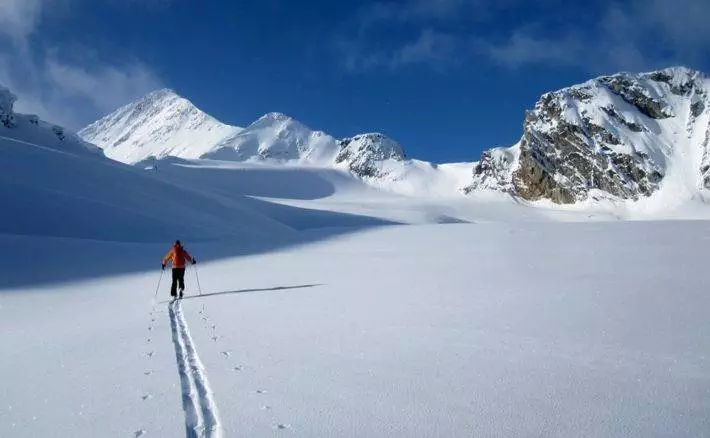The day in the life of a backcountry ski guide might seem like it’s all sunshine and powder turns, but the truth is that it’s a lot more work than that. These men and women rise early, stay late and are always surveying the landscape for potential hazards and safety concerns. It takes quite a few years to achieve accredited guide status with the Association of Canadian Mountain Guides (ACMG) when you add up all the courses, exams, practicums, trips and filling out of log books. Then there’s all the work that goes into a single day trip; hauling heavy packs with everything inside from ropes to a sizable first aid kit, planning routes with multiple alternatives, analyzing data collected from the greater avalanche safety industry. It’s a good thing getting paid to ski powder is such a tangible reward. To give you a sneak peek at what one of these days looks like, we bring you a first-hand account from MSAA backcountry ski guide Randy Heppell on a typical day of leading tours beyond the resort boundaries. Learn how to become more confident with your mountaineering skills with backcountry tours or mountaineering course.

Dawn Patrol
My typical day of backcountry ski guiding actually starts the night before. I do a full gear check so nothing is forgotten in the haze of an early morning. I leave my loaded pack by the door so I’m all ready to go.
At 5:15 a.m. my alarm goes off. I get dressed and make sure to get a healthy breakfast (protein shake and supplements in my case) before a full 20 minutes of yoga and stretching. This part of the day is important to get my (aging) body ready for the day as well as giving me focus and staying centered.
I make some coffee and take 30 minutes on my home computer to review weather and avalanche forecasts, snow conditions and other environmental data from multiple sources. This preparation is key to understanding the conditions once I get to the mountain. I also check the road conditions before my drive in from Squamish. Guiding is about recognizing hazards in all its forms. Become more confident in the backcountry with avalanche training.

Morning Commute
When I hop in the car and pull away from my house, I’m still surveying what’s going on with the weather that day. How intense is the sun hitting those slopes? How much are the trees moving in the wind? Where is the snowline that morning? All these bits of information are pieces to the greater weather puzzle.
I arrive in Whistler and I grab coffee number two from Mt. Currie Coffee Co. before walking across the road to the morning guides meeting at the MSAA office. We grab our guest lists (put together by reservation staff the day before) with details like guest expectations and ability levels.
We kick off the meeting at 7:15 a.m. and discuss snowpack, weather, the best terrain to use and guest groupings. We also formulate a communication plan for the day; arranging a time to check in with a cell phone or radio to compare notes on travel and snow conditions.All guides working that day write a quick trip plan, so the rest of the office staff know approximately where and when we’ll be in the backcountry today.

Meet and greet
It’s now time to meet and greet our guests for the day. I head over to our designated rally point at the Escape Route Alpine Demo Centre and introduce myself to the group. This is one of the most important parts of the day; gauging each guest’s personality and expectations as well as how that will play into the group dynamics today. Have some guests overestimated or underestimated their ability level and/or fitness? What is everyone’s goals for the day?
We walk over as a group and board the Whistler Village Gondola. The roughly 18 to 20-minute ride is a good opportunity for the group members to get to know one another and also a chance for them to voice what they’re looking for out of the day. I.e lots of powder laps or just good scenery for photos?

Now, for the skiing
The first lap of the day is where I assess the actual abilities of each guest. Is someone too advanced or not experienced enough that it may affect the group dynamics significantly? Are there any cowboys that don’t want to listen to instructions? At this point I make adjustments to the route and terrain plan to make sure that:
1. Everyone will be safe
2. Every guest has their best day possible, whatever that may mean to them.
But a typical day of guiding requires constant assessment and reassessment of the terrain and snow conditions. The weather and temperatures may be changing rapidly. A guest might be running out of energy. The mountains are the ones in charge out here, not us. And it’s my job as a guide to listen to the warning signs. A good of day guiding means that the snow is stable, guests enjoy both skinning up and skiing down, they appreciate the mountains and the peace. If everyone is working well together and there is a holistic energy, the group is in a good headspace.
Lunch
When we reach an ideal spot for lunch I break out my Thermos of tea, a high energy sandwich, almond-stuffed figs and a couple pieces of candy for my sweet tooth. The rest of the group settles into a seat (some prefer to stand) as they tuck in to their lunches and chat about their past ski experiences and where they’d like to ski in the future.
I always make sure to keep a pocket stuffed with energy gels/blocks and electrolyte powders. You never know when a guest’s body (or my own) is going to hit a wall. And I’m never in the backcountry without a full one-litre Nalgene water bottle. Staying hydrated and nourished is key, something I always communicate with the guests before we step away from civilization for the day.

Wrapping Up a day in the life of a backcountry ski guide
The remainder of the day consists of more runs and more reassessment of everyone’s energy levels. People start to slow down, some more than others. I have to remember that people still need some fuel in the tank to make it home. We begin our egress and after a quick debrief at the bottom we say our goodbyes.
I meet the rest of the guides at the end of the day to compare notes on the snowpack, what happened in each others groups, where the good skin tracks are any other pertinent information. On the drive home I run through the day in my mind; what worked well, what I could have done better given the circumstances and some mental notes about the weather and snowpack again. Back at home I unpack my gear in the drying room and spend another 20 minutes stretching to avoid nighttime leg cramps. I recharge with a healthy dinner and make sure to drink plenty of water. Because hydration and nourishment is key. Learn more about back country ski guides. Talk to us about our winter backcountry ski tours.
Can’t wait for another day in the life of a backcountry ski guide tomorrow.
Written by: Vince Shuley

